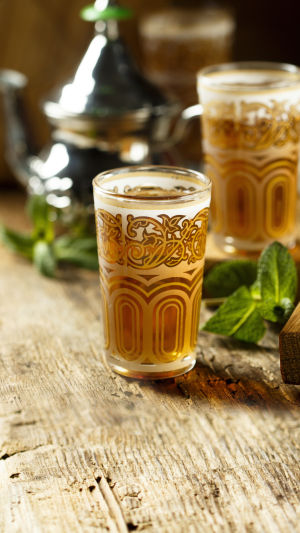<b>Moroccan mint tea</b> is more than just a beverage; it's a symbol of hospitality, tradition, and daily life in Morocco. This cherished drink is an integral part of Moroccan culture, embodying warmth, friendliness, and the rich heritage of the country.
Mint tea in Morocco dates back to the 18th century when tea was introduced by British merchants. Over time, the Moroccans made it their own by adding local ingredients, primarily fresh mint leaves.
The unique combination of green tea, mint, and sugar quickly became a beloved tradition, enjoyed by locals and visitors alike. Ok, Lykkers, today we will delve into the fantastic world of Moroccan mint tea!
<h3>The Ingredients and Preparation</h3>
The preparation of Moroccan mint tea is a meticulous process that reflects the care and attention given to this cherished drink. Here are the essential ingredients:
<b>Green tea:</b> Typically, Chinese gunpowder green tea is used, known for its strong flavor and aroma.
<b>Fresh mint leaves:</b> Spearmint gives the tea its refreshing and invigorating taste.
<b>Sugar:</b> A generous amount of sugar is added, balancing the bitterness of the green tea and the freshness of the mint.
<h3>The Brewing Process</h3>
<b>Rinse the tea:</b> A small amount of boiling water is poured over the green tea leaves and then discarded to rinse away any impurities.
<b>First brew:</b> Add the tea leaves to a teapot and fill it with boiling water. Let it steep for a few minutes.
<b>Add the mint and sugar:</b> Fresh mint leaves and sugar are added to the teapot. The exact amount of sugar can vary, but Moroccan tea is generally very sweet.
<b>Mixing:</b> To ensure a well-mixed tea, the first glass is poured and then returned to the pot several times. This also helps aerate the tea, enhancing its flavor.
<b>Serving:</b> Pour the tea from a height into small glasses as it is believed to not only cool the tea slightly but also aerate the tea.
<h3>Cultural Significance</h3>
In Morocco, mint tea is more than just a drink; it's a gesture of hospitality and friendship. It's often served to guests as a welcoming gesture, and refusing it can be seen as impolite. The tea ceremony is a moment of relaxation and socialization, where people gather to chat, laugh, and enjoy each other's company.
The ritual of serving tea is also an art. The teapot and glasses are often beautifully decorated, and the process of pouring the tea from a height requires skill and practice. This elegant presentation adds to the overall experience, making it visually delightful.
<h3>Health Benefits</h3>
Apart from its cultural significance, Moroccan mint tea offers several health benefits:
<b>Digestive aid:</b> Mint tea is known for its soothing effects on the digestive system, helping to relieve indigestion and bloating.
<b>Refreshing and hydrating:</b> The combination of mint and green tea provides a refreshing and hydrating drink, perfect for hot days.
<b>Rich in antioxidants:</b> Green tea is packed with antioxidants that can boost overall health and immunity.
<h3>Everyday Scenarios</h3>
Whether enjoyed in a bustling café in Marrakech or a serene courtyard in Fes, Moroccan mint tea is a staple of everyday life. It's common to see families enjoying tea after meals, friends gathering for a chat over a pot of mint tea, or shopkeepers offering a glass to potential customers. The ubiquity of mint tea in Morocco is a testament to its enduring appeal and the deep connection it fosters among people.
<h3>Conclusion</h3>
Moroccan mint tea is more than just a delightful beverage; it's a cultural icon that embodies the spirit of Moroccan hospitality and tradition. Its preparation and consumption are woven into the fabric of daily life, offering a moment of connection and comfort. Whether you're a visitor or a local, savoring a glass of mint tea is an experience that captures the essence of Morocco's rich cultural heritage.
Moroccan Mint Tea | Thirsty For ...
Video by Tastemade





